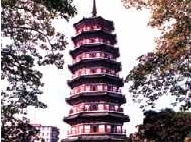|
 Temple
of the Six Banyan Trees,
situated on Liurong
Road, is a world famous
ancient Buddhist temple.
It was built in 537 in
the Liang dynasty during
the Southern dynasties
(386-581). Temple
of the Six Banyan Trees,
situated on Liurong
Road, is a world famous
ancient Buddhist temple.
It was built in 537 in
the Liang dynasty during
the Southern dynasties
(386-581).
More than 1460 years ago
in the Liang dynasty,
Tanyu, the master
priest, under orders of
Emperor Liangwu, built
Baozhuangyan Temple to
store the Buddhist bones
brought from Kampuchea.
During the Northern Song
dynasty, a great writer
- Su Shi, on a visit to
this temple was
attracted by the six
banyan trees surrounding
it and wrote the
inscription "Liu Rong"
(Six Banyan Trees). This
temple has since been
known as Temple of the
Six Banyan Trees.
The temple was burned
down and rebuilt in the
Northern Song dynasty
(960-1127).
Flowery Pagoda, built in
1097, is the major
structure in this
temple. Named for its
colorful exterior, the
pagoda stands 57 meters
high in the center of
the temple, having a
bronze column with 1,000
Buddhist sculptures on
its top. Viewed from
outside, the pagoda has
9 stories while in fact
it has 17stories inside.
To the west of the
pagoda is Grand Hall, a
magnificent hall rebuilt
in 1983 with an area of
300 square meters and a
height of 14 meters. In
this hall are enshrined
three huge images:
Sakyamuni in the middle,
Amitabha left and
Maitreya right.
Elaborately made of
brass in 1633 during the
reign of Emperor Kangxi
of the Qing dynasty,
each is 6m high and
weighing 10 tons, being
the largest existing
ancient brass images in
Guangdong province.
In the Banyan Garden,
there is Hall of Liuzu,
where the copper image
of Liuzu - the sixth
generation of China’s
Buddhist master was
enshrined. This image,
1.8 meters in height and
1 ton in weight, was
meticulously cast in 989
in the Northern Song
dynasty. It looks like
real life, sitting
silently with eyes
closed. |



